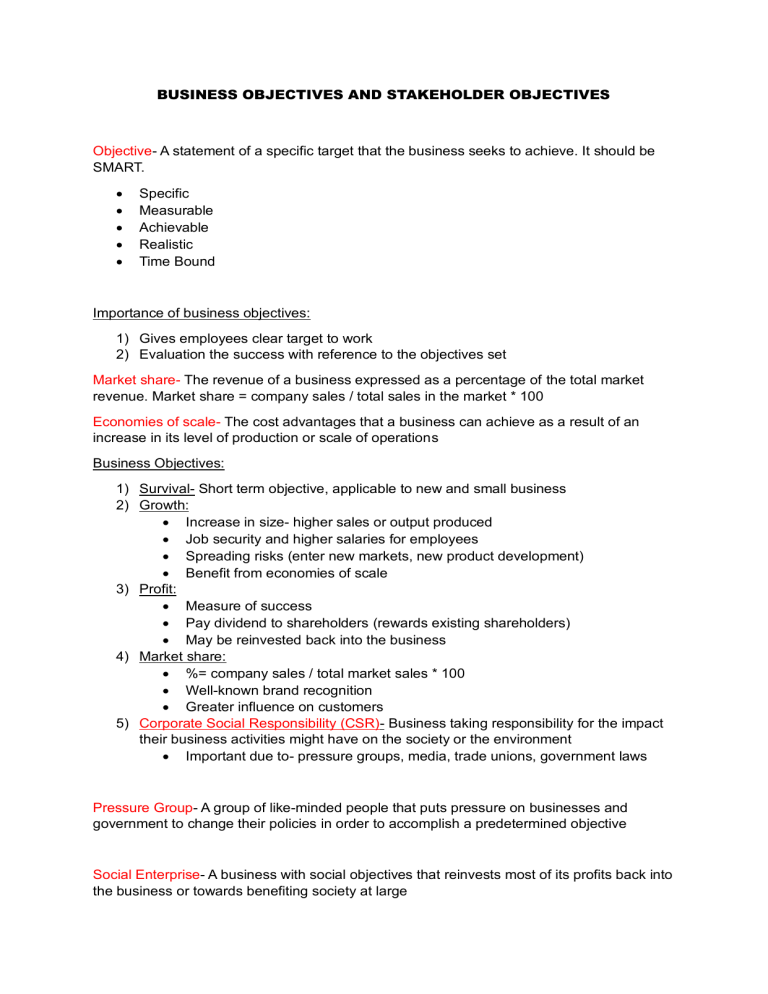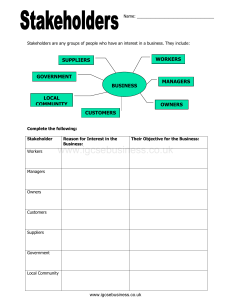
BUSINESS OBJECTIVES AND STAKEHOLDER OBJECTIVES Objective- A statement of a specific target that the business seeks to achieve. It should be SMART. • • • • • Specific Measurable Achievable Realistic Time Bound Importance of business objectives: 1) Gives employees clear target to work 2) Evaluation the success with reference to the objectives set Market share- The revenue of a business expressed as a percentage of the total market revenue. Market share = company sales / total sales in the market * 100 Economies of scale- The cost advantages that a business can achieve as a result of an increase in its level of production or scale of operations Business Objectives: 1) Survival- Short term objective, applicable to new and small business 2) Growth: • Increase in size- higher sales or output produced • Job security and higher salaries for employees • Spreading risks (enter new markets, new product development) • Benefit from economies of scale 3) Profit: • Measure of success • Pay dividend to shareholders (rewards existing shareholders) • May be reinvested back into the business 4) Market share: • %= company sales / total market sales * 100 • Well-known brand recognition • Greater influence on customers 5) Corporate Social Responsibility (CSR)- Business taking responsibility for the impact their business activities might have on the society or the environment • Important due to- pressure groups, media, trade unions, government laws Pressure Group- A group of like-minded people that puts pressure on businesses and government to change their policies in order to accomplish a predetermined objective Social Enterprise- A business with social objectives that reinvests most of its profits back into the business or towards benefiting society at large Why business objectives change? • • Business moves from being a new business to an established business Business has already achieved the objective it had set for itself Stakeholder- Individuals or groups that have an interest in businesses because they are affected by the business’s activities and decisions Internal Stakeholders: • • • Owners & Shareholders Managers Employees External Stakeholders: • • • • • Lenders Suppliers Customers Government Local community INTERNAL STAKEHOLDERS: Owners & Shareholders: • • • Interested in the performance of the business Owners receive profit for risking their investments in the business Shareholders receive dividends & sell shares in the stock market for a higher price than they paid for them Managers: • • Responsible for the performance of the business Receive bonuses or a salary increase if the business performs well Employees: • Employees are interested in the performance of the business. If the business is profitable, it can ensure job security and the chance of increase in wages or salaries EXTERNAL STAKEHOLDERS: Lenders: • • • Check if the business is able to repay the amount borrowed Existing lenders want to know if the business is making enough profit and has enough cash to make these payments Potential lenders will want to know about the long-term profitability of the business Suppliers: • • Want to know if they will get paid on time for the goods supplied to the business. The success of the suppliers depends on the success of the business. If a business is expanding then they will be producing more and will need more inventory. Customers: • • Receive quality goods and after-sales service Be charged a fair price which gives value for money Government: • • Be paid the correct amount of taxes on time To have minimal spending on unemployment benefits Local Community: • • To receive benefits for the local economy such as employment and subsidising of community facilities To avoid negative impact of business activities such as noise, ait and traffic pollution Objectives of Public Sector enterprises: • • • Accessible- they can be used by everyone regardless of their location or income Affordable- they must be cheaper than the same product in the private sector Open to all- they must be available to all regardless of their ethnicity, culture etc.








